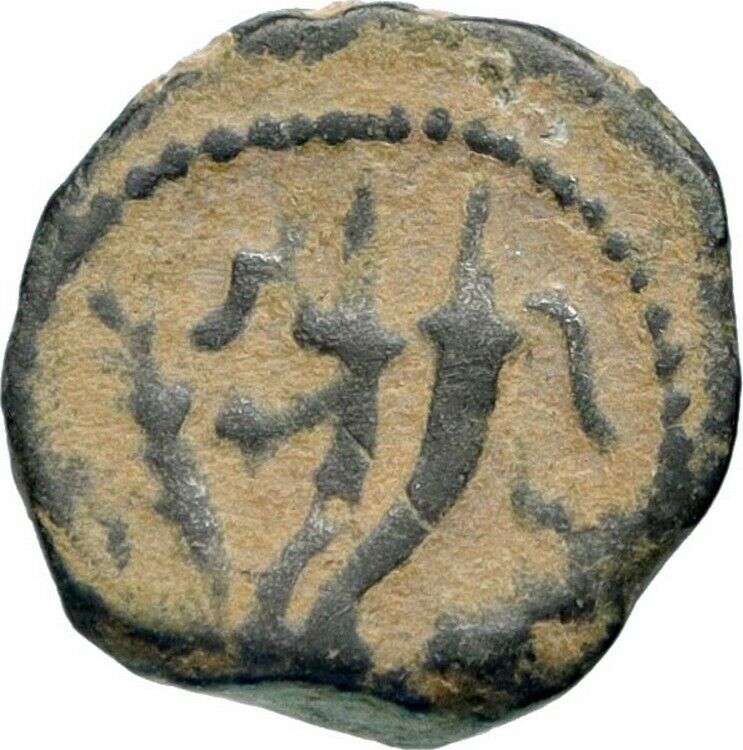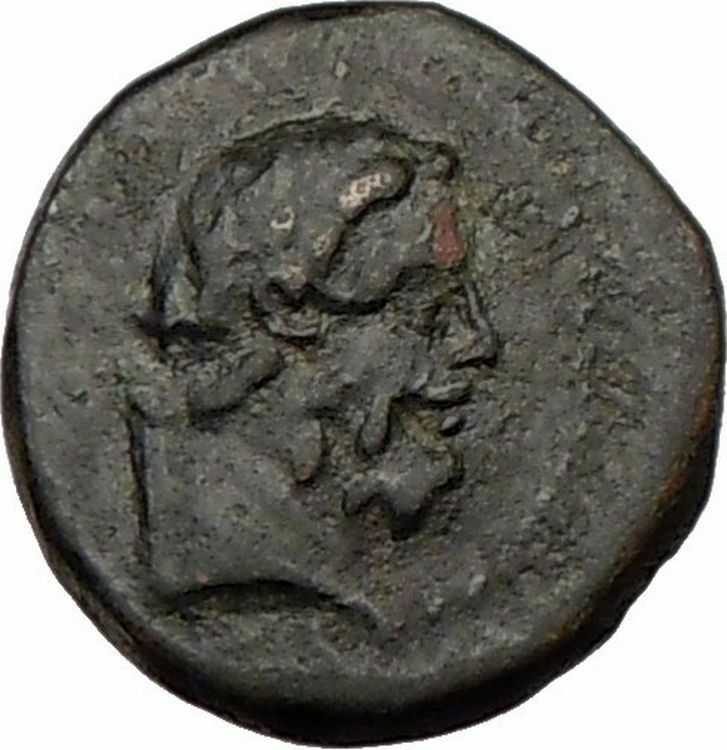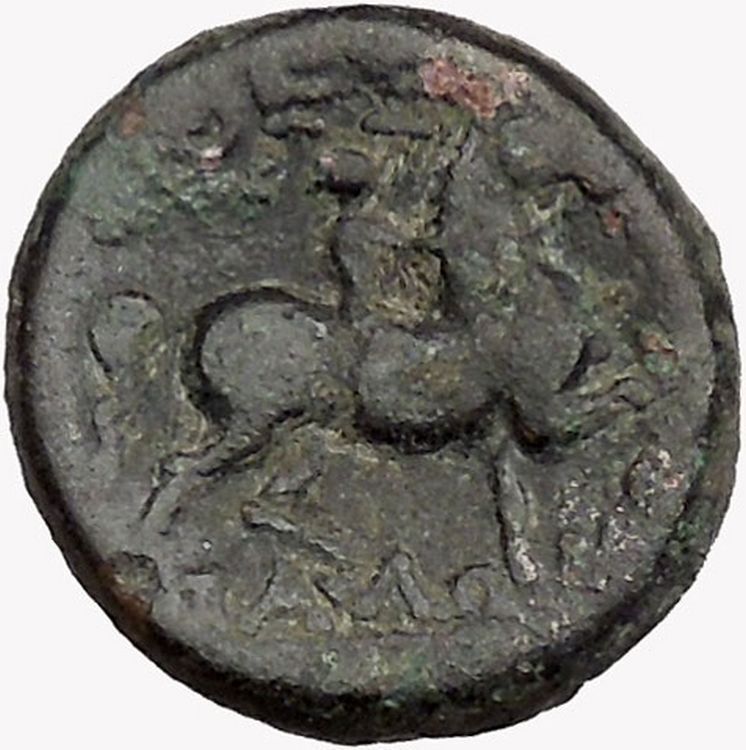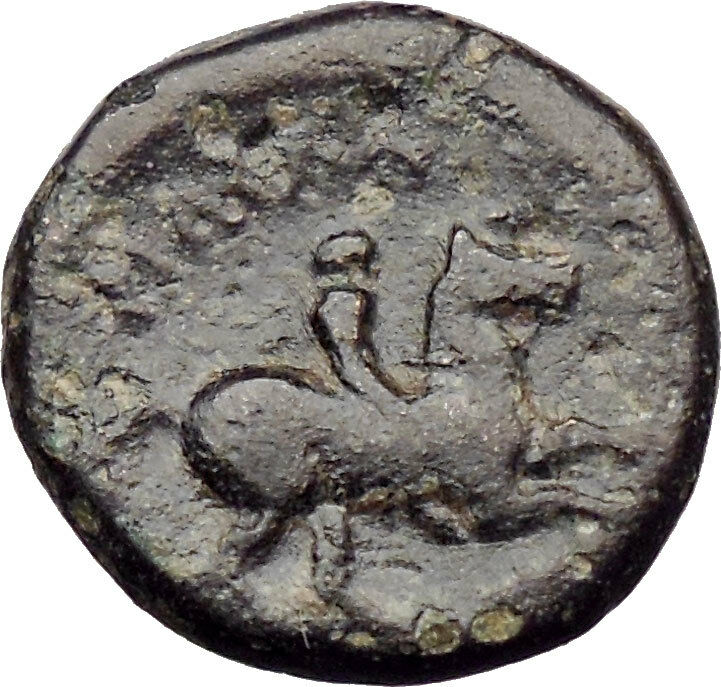|
Greek City of Sardes in Asia Minor
Bronze 14mm (3.79 grams) Struck 133-80 B.C.
Reference: Sear 4736; B.M.C. 22.239,18
Laureate head of Apollo right.
ΣΑΡΔΙ /ΑΝΩΝ either side of club, monogram to right; all within oak-wreath.
The ancient capital of the Lydian Kings, Sardeis lay under a
fortified hill in the Hermos valley, at the important road junction. In the
pre-Alexandrian age it was the center of the principal Persian satrapy, ad in
all probability the mint-place of much of the Persian imperial coinage of darics
and sigloi. In 189 B.C. it came under the rule of the Attalids of Pergamon, and
fifty-six years later it passes to the Romans.
You are bidding on the exact item pictured,
provided with a Certificate of Authenticity and Lifetime Guarantee of
Authenticity.

Apollo Belvedere
,
ca. 120–140 CE
Apollo
is one of the most important and complex of the
Olympian deities
in
ancient Greek
and
Roman religion
,
Greek
and
Roman mythology
, and
Greco
–Roman
Neopaganism
. The ideal of the
kouros
(a beardless, athletic youth),
Apollo has been variously recognized as a god of light and the sun, truth and
prophecy, healing, plague, music, poetry, and more. Apollo is the son of
Zeus and Leto
, and has a twin sister, the chaste
huntress Artemis
. Apollo is known in Greek-influenced
Etruscan mythology
as Apulu.
As
the patron of Delphi
(Pythian Apollo), Apollo was an
oracular
god—the prophetic deity of the
Delphic Oracle
. Medicine and healing are
associated with Apollo, whether through the god himself or mediated through his
son Asclepius
, yet Apollo was also seen as a god
who could bring ill-health and deadly
plague
. Amongst the god’s custodial charges,
Apollo became associated with dominion over
colonists
, and as the patron defender of herds
and flocks. As the leader of the
Muses (Apollon Musegetes) and director of their choir, Apollo
functioned as the patron god of music and poetry.
Hermes
created the
lyre for him, and the instrument became a common
attribute of Apollo
. Hymns sung to Apollo were
called paeans
.
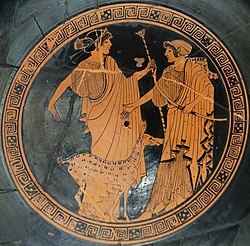
Apollo (left) and
Artemis
.
Brygos
(potter signed), Tondo of an
Attic red-figure cup c. 470 BC,
Musée du Louvre
.
In Hellenistic times, especially during the 3rd century BCE, as Apollo
Helios he became identified among Greeks with
Helios
,
Titan
god of the sun
, and his sister Artemis
similarly equated with
Selene
, Titan
goddess of the moon
In Latin texts, on the other hand,
Joseph Fontenrose
declared himself unable to
find any conflation of Apollo with
Sol
among the
Augustan poets
of the 1st century, not even in
the conjurations of Aeneas
and
Latinus
in
Aeneid
XII (161–215).
Apollo and Helios/Sol remained separate beings in literary and mythological
texts until the 3rd century CE.
Etymology

Statuette of the Apollo Lykeios type,
Museum of the Ancient Agora of Athens
(inv. BI 236).
Apollo was worshipped throughout the
Roman Empire
. In the traditionally
Celtic
lands he was most often seen as a
healing and sun god. He was often equated with
Celtic gods
of similar character.
Apollo Atepomarus
(“the great horseman”
or “possessing a great horse”). Apollo was worshipped at
Mauvières
(Indre).
Horses were, in the Celtic world, closely linked to the sun.
Apollo Belenus
(‘bright’ or
‘brilliant’). This epithet was given to Apollo in parts of
Gaul
, Northern Italy and
Noricum
(part of modern Austria). Apollo
Belenus was a healing and sun god.
Apollo Cunomaglus
(‘hound lord’). A
title given to Apollo at a shrine in
Wiltshire
. Apollo Cunomaglus may have been
a god of healing. Cunomaglus himself may originally have been an independent
healing god.
Apollo Grannus
. Grannus was a healing
spring god, later equated with Apollo.- Apollo Maponus. A god known from inscriptions in Britain. This
may be a local fusion of Apollo and
Maponus
.
Apollo Moritasgus
(‘masses of sea
water’). An epithet for Apollo at Alesia, where he was worshipped as god of
healing and, possibly, of physicians.
Apollo Vindonnus
(‘clear light’).
Apollo Vindonnus had a temple at
Essarois
, near
Châtillon-sur-Seine
in
Burgundy
. He was a god of healing,
especially of the eyes.
Apollo Virotutis
(‘benefactor of
mankind?’). Apollo Virotutis was worshipped, among other places, at Fins
d’Annecy (Haute-Savoie)
and at Jublains
(Maine-et-Loire).
Origins

The Omphalos
in the Museum of
Delphi
.
The cult centers of Apollo in Greece,
Delphi
and
Delos
, date from the 8th century BCE. The Delos
sanctuary was primarily dedicated to
Artemis
, Apollo’s twin sister. At Delphi,
Apollo was venerated as the slayer of
Pytho
. For the Greeks, Apollo was all the Gods
in one and through the centuries he acquired different functions which could
originate from different gods. In
archaic Greece
he was the
prophet
, the oracular god who in older times
was connected with “healing”. In
classical Greece
he was the god of light and of
music, but in popular religion he had a strong function to keep away evil.
From his eastern-origin Apollo brought the art of inspection from “symbols
and omina
” (σημεία και τέρατα : semeia kai
terata), and of the observation of the
omens of the days. The inspiration oracular-cult was probably
introduced from Anatolia
. The
ritualism
belonged to Apollo from the
beginning. The Greeks created the
legalism
, the supervision of the orders of the
gods, and the demand for moderation and harmony. Apollo became the god of
shining youth, the protector of music, spiritual-life, moderation and
perceptible order. The improvement of the old
Anatolian
god, and his elevation to an
intellectual sphere, may be considered an achievement of the
Greek
people.
Healer and
god-protector from evil
The function of Apollo as a “healer” is connected with
Paean
, the physician of the Gods
in the Iliad
, who seems to come from a more
primitive religion. Paeοn is probably connected with the
Mycenean
Pa-ja-wo, but the etymology is the
only evidence. He did not have a separate cult, but he was the personification
of the holy magic-song sung by the magicians that was supposed to cure disease.
Later the Greeks knew the original meaning of the relevant song “paean”.
The magicians were also called “seer-doctors”, and they used an
ecstatic prophetic art which was used exactly by the god Apollo at the oracles.
In the Iliad, Apollo is the healer under the gods, but he is also the
bringer of disease and death with his arrows, similar to the function of the
terrible
Vedic
god of disease
Rudra
.He sends a terrible plague to the
Achaeans
. The god who sends a disease can also
prevent from it, therefore when it stops they make a purifying ceremony and
offer him an “hecatomb” to ward off evil. When the oath of his priest appeases,
they pray and with a song they call their own god, the beautiful Paean.
Some common epithets of Apollo as a healer are “paion” , “epikourios”, “oulios”, and “loimios” . In
classical times, his strong function in popular religion was to keep away evil,
and was therefore called “apotropaios” and “alexikakos” ,
throw away the evil).
In later writers, the word, usually spelled “Paean”, becomes a mere epithet of
Apollo in his capacity as a god of
healing
.
Homer illustrated Paeon the god, and the song both of
apotropaic
thanksgiving or triumph. Such songs were originally addressed to
Apollo, and afterwards to other gods: to
Dionysus
, to Apollo
Helios
, to Apollo’s son
Asclepius
the healer. About the 4th century
BCE, the paean became merely a formula of adulation; its object was either to
implore protection against disease and misfortune, or to offer thanks after such
protection had been rendered. It was in this way that Apollo had become
recognised as the god of music. Apollo’s role as the slayer of the
Python
led to his association with battle and
victory; hence it became the
Roman
custom for a paean to be sung by an army
on the march and before entering into battle, when a fleet left the harbour, and
also after a victory had been won.
Dorian origin
The connection with Dorians and their initiation festival
apellai
is reinforced by the month
Apellaios in northwest Greek calendars,
but it can explain only the Doric type of the name, which is connected with the
Ancient Macedonian
word “pella” (Pella),
stone. Stones played an important part in the cult of the god, especially
in the oracular shrine of Delphi (Omphalos).
The “Homeric hymn” represents Apollo as a Northern intruder. His arrival must
have occurred during the “dark ages” that followed the destruction of the
Mycenaean civilization
, and his conflict with
Gaia
(Mother Earth) was represented by the
legend of his slaying her daughter the serpent
Python
.
The earth deity had power over the ghostly world, and it is believed that she
was the deity behind the oracle.
The older tales mentioned two dragons who were perhaps intentionally conflated.
A female dragon named
Delphyne
who is obviously
connected with Delphi and Apollo Delphinios, and a male serpent
Typhon
, the adversary of
Zeus in the
Titanomachy
, who the narrators confused with
Python
.
Python was the good daemon of the temple as it appears in
Minoan
religion,
but she was represented as a dragon, as often happens in Northern European
folklore as well as in the East.
Apollo and his sister
Artemis
can bring death with their arrows. The
conception that diseases and death come from invisible shots sent by
supernatural beings, or magicians is common in
Germanic
and
Norse
mythology.[35]
In
Greek mythology
Artemis was the leader of the
nymphs
, who had similar functions with the
Nordic
Elves.The “elf-shot” originally indicated disease or death attributed to the elves,
but it was later attested denoting
arrow
-heads which were used by witches to harm
people, and also for healing rituals.
The
Vedic
Rudra has some similar functions with
Apollo. The terrible god is called “The Archer”, and the bow is also an
attribute of Shiva
.
Rudra could bring diseases with his arrows, but he was able to free people of
them, and his alternative Shiba, is a healer physician god.
However the
Indo-European
component of Apollo, does not
explain his strong relation with omens, exorcisms, and with the oracular cult.
Minoan origin
It seems an oracular cult existed in Delphi from the
Mycenaean
ages.
In historical times, the priests of Delphi were called
Labryaden
, “the double-axe men”, which
indicates
Minoan
origin. The double-axe (λάβρυς:labrys)
was the holy symbol of the
Cretan
labyrinth
.
The Homeric hymn adds that Apollo appeared as a dolphin and carried Cretan
priests to Delphi, where they evidently transferred their religious practices.
Apollo Delphinios was a sea-god especially worshiped in Crete and in the
islands, and his name indicates his connection with Delphi
and the holy serpent
Delphyne
(womb). Apollo’s sister
Artemis
, who was the Greek goddess of hunting,
is identified with
Britomartis
(Diktynna),
the
Minoan
“Mistress of the animals”. In her
earliest depictions she is accompanied by the “Mister of the animals”, a male
god of hunting who had the bow as his attribute. We don’t know his original
name, but it seems that he was absorbed by the more powerful Apollo, who stood
by the “Mistress of the animals”, becoming her brother.
The old oracles in Delphi seem to be connected with a local tradition of the
priesthood, and there is not clear evidence that a kind of inspiration-prophecy
existed in the temple. This led some scholars to the conclusion that Pythia
carried on the rituals in a consistent procedure through many centuries,
according to the local tradition. In that regard, the mythical seeress
Sibyl
of
Anatolian
origin, with her ecstatic art, looks
unrelated to the oracle itself.However, the Greek tradition is referring to the existence of vapours and
chewing of laurel-leaves, which seem to be confirmed by recent studies.
Plato
describes the priestesses of Delphi and
Dodona
as frenzied women, obsessed by “mania” (μανία:frenzy),
a Greek word connected with “mantis” (μάντις:prophet). Frenzied women like
Sibyls from whose lips the god speaks are recorded in the
Near East
as
Mari
in the second millennium BC.Although Crete had contacts with Mari from 2000 BC,
there is no evidence that the ecstatic prophetic art existed during the Minoan
and Mycenean ages. It is more probable that this art was introduced later from
Anatolia
and regenerated an existing oracular
cult that was local to Delphi and dormant in several areas of Greece.
Anatolian origin
A non-Greek origin of Apollo has long been assumed in scholarship.The name of Apollo’s mother
Leto has Lydian
origin, and she was worshipped on the
coasts of
Asia Minor
. The inspiration oracular cult was
probably introduced into Greece from
Anatolia
, which is the origin of
Sibyl
, and where existed some of the oldest
oracular shrines. Omens, symbols, purifications, and exorcisms appear in old
Assyro
–Babylonian
texts, and these rituals were spread into the empire of the
Hittites
. In a Hittite text is mentioned that
the king invited a Babylonian priestess for a certain “purification”.
A similar story is mentioned by
Plutarch
. He writes that the
Cretan
–
seer
Epimenides
, purified
Athens
after the pollution brought by the
Alcmeonidae
, and that the seer’s expertise in
sacrifices
and reform of funeral practices were
of great help to Solon
in his reform of the Athenian state.
The story indicates that Epimenides was probably heir to the shamanic religions
of Asia, and proves together with the
Homeric
hymn, that Crete had a resisting
religion up to the historical times. It seems that these rituals were dormant in
Greece, and they were reinforced when the Greeks migrated to
Anatolia
.
Homer
pictures Apollo on the side of the
Trojans, fighting against the
Achaeans
, during the
Trojan War
. He is pictured as a terrible god,
less trusted by the Greeks than other gods. The god seems to be related to
Appaliunas, a tutelary god of
Wilusa
(Troy)
in Asia Minor, but the word is not complete.
The stones found in front of the gates of
Homeric
Troy were the symbols of Apollo. The
Greeks gave to him the name αγυιεύς
agyieus
as the protector god of public places
and houses who wards off evil, and his symbol was a tapered stone or column.
However, while usually Greek festivals were celebrated at the
full moon
, all the feasts of Apollo were
celebrated at the seventh day of the month, and the emphasis given to that day (sibutu)
indicates a
Babylonian
origin.
The
Late Bronze Age
(from 1700 to 1200 BCE)
Hittite
and
Hurrian
Aplu was a god of
plague
, invoked during plague years. Here we
have an
apotropaic
situation, where a god originally
bringing the plague was invoked to end it. Aplu, meaning the son of, was
a title given to the god
Nergal
, who was linked to the
Babylonian
god of the sun
Shamash
.
Homer interprets Apollo as a terrible god (δεινός θεός) who brings death and
disease with his arrows, but who can also heal, possessing a magic art that
separates him from the other Greek gods.
In Iliad
, his priest prays to Apollo
Smintheus,
the mouse god who retains an older agricultural function as the protector from
field rats.
All these functions, including the function of the healer-god
Paean
, who seems to have Mycenean origin, are
fused in the cult of Apollo.
Oracular cult

Columns of the
Temple of Apollo
at Delphi, Greece.
Unusually among the Olympic deities, Apollo had two cult sites that had
widespread influence: Delos
and
Delphi
. In cult practice,
Delian Apollo
and
Pythian Apollo
(the Apollo of Delphi) were so
distinct that they might both have shrines in the same locality.Apollo’s
cult
was already fully established when written
sources commenced, about 650 BCE. Apollo became extremely important to the Greek
world as an oracular deity in the
archaic period
, and the frequency of
theophoric names
such as Apollodorus or
Apollonios and cities named Apollonia testify to his popularity.
Oracular sanctuaries to Apollo were established in other sites. In the 2nd and
3rd century CE, those at
Didyma
and
Clarus
pronounced the so-called “theological
oracles”, in which Apollo confirms that all deities are aspects or servants of
an
all-encompassing, highest deity
. “In the 3rd
century, Apollo fell silent.
Julian the Apostate
(359 – 61) tried to revive
the Delphic oracle, but failed

In
Greek
and
Roman mythology
, Apollo
,
is one of the most important and diverse of the
Olympian deities
. The ideal of the
kouros
(a
beardless youth), Apollo has been variously recognized as a god of light and the
sun; truth and prophecy;
archery
;
medicine and healing; music, poetry, and the arts; and more. Apollo is the son
of Zeus
and
Leto, and has a
twin
sister, the chaste huntress
Artemis
.
Apollo is known in Greek-influenced
Etruscan mythology
as Apulu. Apollo was worshiped in both
ancient Greek
and
Roman religion
, as well as in the modern
Greco
–Roman
Neopaganism
.
As the patron of Delphi
(Pythian Apollo), Apollo was an
oracular
god � the prophetic deity of the
Delphic Oracle
.
Medicine and healing were associated with Apollo, whether through the god
himself or mediated through his son
Asclepius
,
yet Apollo was also seen as a god who could bring ill-health and deadly
plague
as well as one who had the ability to cure. Amongst the god’s
custodial charges, Apollo became associated with dominion over
colonists
, and as the patron defender of herds and flocks. As the leader of
the Muses
(Apollon
Musagetes) and director of their choir, Apollo functioned as the patron god
of music and poetry
.
Hermes
created
the lyre
for him,
and the instrument became a common
attribute
of Apollo. Hymns sung to Apollo were called
paeans
.
In Hellenistic times, especially during the third century BCE, as Apollo
Helios he became identified among Greeks with
Helios
,
god of
the sun
, and his sister Artemis similarly equated with
Selene
,
goddess
of the moon
.
In Latin texts, on the other hand, Joseph Fontenrose declared himself unable to
find any conflation of Apollo with
Sol
among the
Augustan poets
of the first century, not even in the conjurations of
Aeneas
and
Latinus
in
Aeneid
XII
(161–215).
Apollo and Helios/Sol remained separate beings in literary and mythological
texts until the third century CE.
Sardis, also Sardes (Lydian:
Sfard,
Greek
: Σά��δει�‚,
Persian
: Sparda), modern Sart in the
Manisa
province
of Turkey
, was
the capital of the ancient kingdom of
Lydia
, one of the
important cities of the
Persian Empire
, the seat of a
proconsul
under the
Roman
Empire
, and the metropolis of the province Lydia in later Roman and
Byzantine
times. As one of the
Seven churches of Asia
, it was addressed by the author of the
Book of Revelation
in terms which seem to imply that its population was
notoriously soft and fainthearted. Its importance was due, first to its military
strength, secondly to its situation on an important highway leading from the
interior to the
Aegean
coast, and thirdly to its commanding the wide and fertile plain of the Hermus.
//
Geography

Map of Sardis and Other Cities within the Lydian Empire
Sardis was situated in the middle of
Hermus
valley, at the foot of
Mount Tmolus
, a steep and lofty spur which formed the citadel. It was about
4 kilometres (2.5 mi) south of the Hermus. Today, the site is located by the
present day village of Sart, near
Salihli
in
the Manisa province of Turkey, close to the
Ankara
–
Ä°zmir
highway
(approximately 72 kilometres (45 mi) from
Ä°zmir
). The part
of remains including the bath-gymnasium complex, synagogue and Byzantine shops
is open to visitors year-round.
History
The earliest reference to Sardis is in the
The
Persians
of
Aeschylus
(472 BC); in the Iliad
the name Hyde seems to be given to the city of the
Maeonian
(i.e. Lydian) chiefs, and in later times Hyde was said to be the
older name of Sardis, or the name of its citadel. It is, however, more probable
that Sardis was not the original capital of the Maeonians, but that it became so
amid the changes which produced the powerful Lydian empire of the 8th century
BC.
The city was captured by the
Cimmerians
in the 7th century, by the
Persians
and by the
Athenians
in
the 6th, and by
Antiochus III the Great
at the end of the 3rd century. In the Persian era
Sardis was conquered by
Cyrus the Great
and formed the end station for the Persian
Royal Road
which began in
Persepolis
,
capital of
Persia
. During the
Ionian Revolt
, the
Athenians
burnt down the city. Sardis remained under Persian domination
until it surrendered to
Alexander the Great
in 334 B.C..
Once at least, under the emperor
Tiberius
,
in 17 AD, it was destroyed by an earthquake; but it was always rebuilt. It was
one of the great cities of western
Asia Minor
until the later Byzantine period.
The early Lydian kingdom was far advanced in the industrial arts and Sardis
was the chief seat of its manufactures. The most important of these trades was
the manufacture and dyeing of delicate woolen stuffs and carpets. The stream
Pactolus
which flowed through the market-place “carried golden sands” in early antiquity,
in reality gold dust out of Mt. Tmolus; later, trade and the organization of
commerce continued to be sources of great wealth. After
Constantinople
became the capital of the East, a new road system grew up
connecting the provinces with the capital. Sardis then lay rather apart from the
great lines of communication and lost some of its importance. It still, however,
retained its titular supremacy and continued to be the seat of the
metropolitan bishop
of the province of Lydia, formed in 295 AD. It is
enumerated as third, after
Ephesus
and
Smyrna
, in the
list of cities of the
Thracesion
thema
given by
Constantine Porphyrogenitus
in the 10th century; but over the next four
centuries it is in the shadow of the provinces of Magnesia-upon-Sipylum and
Philadelphia, which retained their importance in the region.
After 1071 the Hermus valley began to suffer from the inroads of the
Seljuk Turks
but the successes of the general
Philokales
in 1118 relieved the district and the ability of the
Comneni
dynasty together with the gradual decay of the
Seljuk Sultanate of Rum
retained it under Byzantine dominion. When
Constantinople
was taken by the
Venetians
and Franks
in 1204 Sardis came under the rule of the Byzantine
Empire of Nicea
. However once the Byzantines retook Constantinople in 1261,
Sardis with the entire
Asia Minor
was neglected and the region eventually fell under the control of
Ghazi (Ghazw)
emirs, the
Cayster
valleys and a fort on the citadel of Sardis was handed over to them
by treaty in 1306. The city continued its decline until its capture (and
probable destruction) by the
Mongol
warlord Timur
in 1402.
Archaeological
expeditions
By the nineteenth century, Sardis was in ruins, showing construction chiefly
of the Roman period. The first large scale archaeological expedition in Sardis
was directed by a
Princeton University
team between years 1910 – 1914, unearthing the Temple
of Artemis, and more than a thousand Lydian tombs. The excavation campaign was
halted by World War I
, followed by the
Turkish War of Independence
. Some surviving artifacts from the Butler
excavation were added to the collection of the
Metropolitan Museum of Art
in
New York
.
The excavation is currently under the directorship of Nick Cahill, professor
at the
University of Wisconsin–Madison
. 4[citation
needed]The laws governing archaeological expeditions in Turkey
ensure that all archaeological artifacts remain in Turkey. Some of the important
finds from the site of Sardis are housed in the
Archaeological Museum of Manisa
, including Late Roman mosaics and sculpture,
a helmet from the mid-6th century BC, and pottery from various periods.
Sardis
synagogue
Since 1958, both
Harvard
and
Cornell Universities
have sponsored annual archeological expeditions to
Sardis. These excavations unearthed perhaps the most impressive synagogue in the
western diaspora yet discovered from antiquity, yielding over eighty Greek and
seven Hebrew inscriptions as well as numerous mosaic floors. (For evidence in
the east, see
Dura Europos
in Syria
.) The discovery of the Sardis synagogue has reversed previous
assumptions about Judaism in the later Roman empire. Along with the discovery of
the godfearers
/theosebeis inscription from the
Aphrodisias
, it provides indisputable evidence for the continued vitality of
Jewish communities in Asia Minor, their integration into general Roman imperial
civic life, and their size and importance at a time when many scholars
previously assumed that Christianity had eclipsed Judaism.[
neededcitation]
The synagogue was a section of a large bath-gymnasium complex, that was in
use for about 450 – 500 years. In the beginning, middle of the second century
AD, the rooms the synagogue is situated in were used as changing rooms or
resting rooms. The complex was destroyed in 616 AD by the Sassanian-Persians.[
neededcitation]
|












